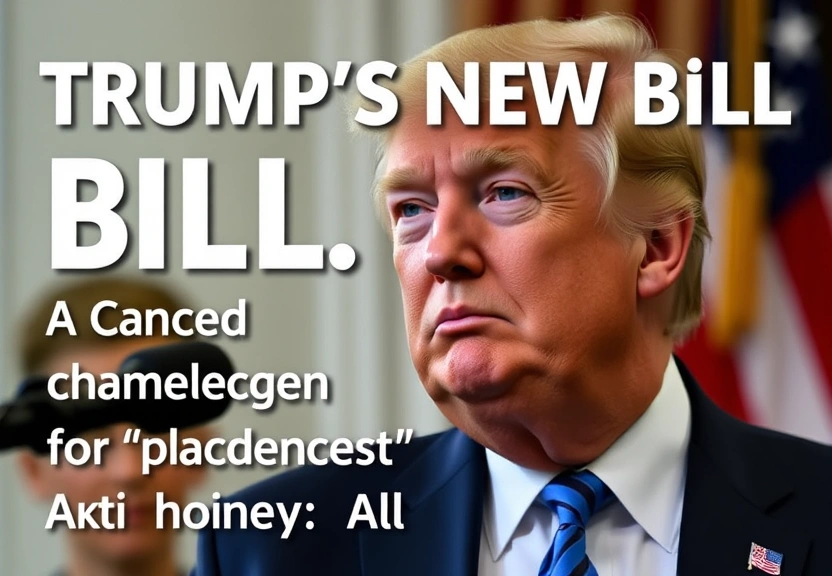Trump’s New Bill: A Game-Changer for Charitable Tax Breaks for All Americans
In a significant shift towards enhancing charitable contributions in the United States, former President Donald Trump has unveiled a new bill that proposes an “above-the-line” deduction for charitable giving. This groundbreaking legislation is anticipated to generate an impressive $74 billion for nonprofits over the next decade, fundamentally altering the landscape of charitable tax breaks. As Americans navigate their financial obligations, this bill aims to incentivize philanthropy while supporting the vital work of organizations across the country.

The proposed above-the-line deduction allows taxpayers to deduct charitable donations directly from their gross income before calculating their taxable income. This reform is expected to benefit not only high-income earners but also average Americans, enabling a broader demographic to contribute to charitable causes without facing the limitations of itemizing deductions. As the nation continues to grapple with economic challenges, this legislative effort presents an opportunity to bolster the nonprofit sector and empower citizens to make a difference in their communities.
Understanding the Above-the-Line Deduction
The above-the-line deduction is a crucial component of Trump’s new bill. Unlike traditional deductions that require taxpayers to itemize their expenses, this approach simplifies the process and encourages more individuals to donate to charity. By allowing taxpayers to deduct contributions directly from their gross income, the new legislation ensures that charitable giving is accessible and advantageous for a wider audience.
What Does Above-the-Line Mean?
The term “above-the-line” refers to the placement of the deduction on the tax form. Above-the-line deductions reduce the taxpayer’s adjusted gross income (AGI) before calculating taxable income, thus providing an immediate benefit. This contrasts with below-the-line deductions, which only benefit those who itemize their deductions and can lead to a significant loss of potential contributions.
The Benefits of the Above-the-Line Deduction
- Increased Accessibility: More taxpayers can take advantage of the deduction, regardless of whether they itemize.
- Encouragement of Philanthropy: By reducing the tax burden associated with donations, more individuals may be motivated to contribute to charitable causes.
- Support for Nonprofits: An influx of donations could help sustain and grow nonprofit organizations that rely on public support.
- Simplified Tax Filing: Streamlining the deduction process may lead to a more straightforward experience during tax season.
The Economic Impact on Nonprofits
The introduction of this above-the-line deduction is projected to generate $74 billion for nonprofits over a decade. This influx of funds could be transformative for the sector, which has faced funding challenges in recent years. The bill’s potential to drive donations is particularly critical as nonprofits often operate on tight budgets while addressing essential community needs.
Addressing Funding Shortfalls
Nonprofits play a vital role in providing services, advocating for social change, and supporting vulnerable populations. However, many organizations struggle to secure consistent funding. With the anticipated rise in charitable contributions facilitated by Trump’s new bill, nonprofits could see a significant increase in resources. This additional funding can help sustain existing programs and create new initiatives that address emerging community challenges.
Encouraging Diverse Contributions
One of the most promising aspects of the above-the-line deduction is its ability to encourage a diverse range of contributions. By making charitable giving more appealing to all taxpayers, the legislation opens the door for increased support from various demographics. This could lead to greater investment in causes that are often underfunded, such as environmental conservation, educational initiatives, and social justice programs.
The Political Landscape Surrounding the Bill
The introduction of Trump’s charitable tax break bill is not without its political implications. The proposal has sparked discussions among lawmakers, tax reform advocates, and nonprofit leaders. While many support the initiative, there are also concerns about its impact on government revenue and potential challenges in implementation.
Support and Opposition
Supporters of the bill argue that enhancing charitable tax breaks is a win-win for taxpayers and nonprofits alike. They contend that encouraging philanthropy can lead to significant societal benefits. Conversely, critics express concern about the potential loss of tax revenue, which could impact government funding for essential services. As debates unfold, the future of the bill will depend on bipartisan support and collaboration.
The Role of Nonprofit Advocacy
Nonprofit organizations play a crucial role in advocating for policies that support their missions. As the conversation around Trump’s bill continues, nonprofit leaders can engage in advocacy efforts to promote the positive implications of the above-the-line deduction. By voicing their support, nonprofits can help shape public perception and influence lawmakers’ decisions.
Frequently Asked Questions (FAQ)
1. What is the above-the-line deduction for charitable giving?
The above-the-line deduction allows taxpayers to deduct charitable contributions directly from their gross income, simplifying the process and making it accessible to more individuals.
2. How much revenue is expected to be generated for nonprofits?
Trump’s new bill is projected to generate $74 billion for nonprofits over a decade.
3. Who will benefit from the above-the-line deduction?
The deduction is designed to benefit all taxpayers, regardless of whether they itemize their deductions.
4. What impact could this bill have on the nonprofit sector?
The anticipated increase in charitable contributions could provide essential funding for nonprofits, enabling them to sustain and expand their programs.
5. Are there any criticisms of the bill?
Some critics express concerns about potential revenue loss for the government and question the long-term sustainability of the proposed tax breaks.
Conclusion
Trump’s new bill introducing an above-the-line deduction for charitable giving represents a significant policy shift aimed at boosting philanthropic efforts across the United States. With the potential to generate $74 billion for nonprofits over the next decade, this legislation could provide vital support for organizations that address crucial social issues. As the political landscape evolves, the success of this bill will depend on collaboration among lawmakers, nonprofit leaders, and the public. By fostering a culture of giving, this initiative has the potential to create lasting positive change in communities nationwide.
📰 Original Source
Este artigo foi baseado em informações de: https://www.marketwatch.com/story/how-trumps-big-bill-makes-it-easier-for-all-americans-to-get-a-tax-break-for-charitable-donations-not-just-rich-people-d3bd0e8e?mod=mw_rss_topstories


